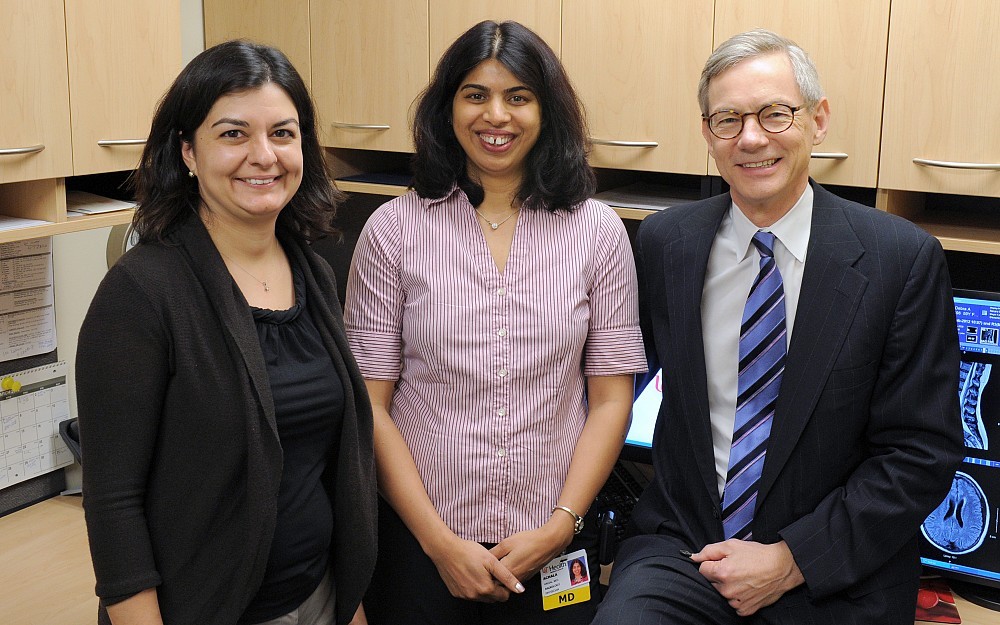
Neuroradiologist Pursues Clinician-Scientist Track With Scholarship Support and Strong UC Mentors
Achala Vagal, MD, is passionate about research. Like many busy clinicians, though, she found it difficult to carve out sufficient time to pursue her research interests in a meaningful way.
Vagala UC College of Medicine assistant professor and neuroradiologist with UC Health University Hospitaldecided she would set her sights on becoming a "clinician-scientist, splitting her time between clinical practice and research.
Her recent selection as the 2012 American Roentgen Ray Society (ARRS) Elio Bracco Scholar is making these aspirations a reality. The elite professional scholarship, which begins July 1 and continues for two years, recognizes her promise as a researcher and provides funding to offset the costs of her time dedicated to research and education.
Internal Research Training, Coaching Resources
When Vagal began looking for resources to pursue her research aspirations, she was impressed with the support available right here on the UC medical campus through the Center for Clinical and Translational Science and Training (CCTST) and UC Office of Research.
The CCTST connected her with the certificate of clinical and translational science through the UC environmental health department in early 2011 to begin her formal training in research. The certificate program is designed to give physicians, fellows and other medical professionals an introduction to clinical and translational research. Students have the option to transition into the masters in clinical and translational science offer for a more in-depth training in epidemiology, study design, biostatistics, ethical issues and many other areas.
A grant writing workshop offered through the UC Office of Research helped hone her research project proposal to submit as part of her ARRS scholarship application. She says the grant writing workshop was an enlightening experience.
"I knew when I submitted a 1½-page abstract and got an eight-page review back that I had a lot to learn, she recalls. "The workshop really helped me understand what funders are looking for, how to communicate that to them effectively and in a logical way. Understanding what will get reviewers attention was a great lesson for me.
Vagal credits the strength of her mentorship team with opening doors for her and guiding her down the right path.
"I feel blessed to have such inspiring role models. says Vagal about her mentors, who include UCs (neurology) Pooja Khatri, MD, (neuroradiology) Thomas Tomsick, MD, and (internal medicine outcomes research) Michael Yi, MD.
"I have benefited from their leadership and the input of the entire neuroscience team, Vagal adds "A special thanks to Pooja who invested endless hours with me, helping me hone my research proposal and my educational plan. My mentoring team was a big reason I bagged this career development award. Also, my chairperson (Jannette Collins, MD) and neuroradiology operations chief (Mary Gaskill-Shipley, MD) were 100 percent supportive of this endeavor, which is a critical prerequisite. A junior faculty member cannot follow this path without full departmental support.
These mentors, says Vagal, provided the professional insights, resource connections and moral support she needed to pursue the clinician-scientist track, a relatively uncommon career choice in radiology.
Vagal says: "Some of my colleagues joked that theyd rather poke hot irons in their eyes than go back to school to study statistical analysis and epidemiology, but I felt like I need those fundamental skills to be an effective researcher.
Utilizing the Scholarship Dollars
Vagal plans to use the $140,000 ARRS scholarship to implement a new clinical studycurrently under review with the UC IRBto analyze the role of delayed ischemic penumbras in clinical decision-making for acute stroke therapy.
The clinical studycalled "PREDICT: Penumbral Relation to Clinical Outcome and Timewill address a yet-to-be answered question in stroke therapy: what is the natural fate of penumbra (salvageable brain tissue) beyond nine hours after acute stroke?
Clinical dogma says that without reperfusion, penumbral tissue will progress to infarction, irrespective of time from stroke onset. As a result, says Vagal, penumbra older than nine hours from time of stroke onset is increasingly being treated with reperfusion even though the benefit of such intervention has not been validated.
"The problem is that there are no control studies of untreated patients against which to compare delayed reperfusion outcomes, says Vagal.
On the education side, she will transition into the masters of clinical and translational science program this spring.
"This is such an exciting professional opportunity, and I am so thankful for both the scholarship and the support of my department, division and mentors for helping me get there. I think my learning journey has just begun.
About the CCTST
CCTST is the academic home of the universitys institutional Clinical and Translational Science Award (CTSA)a $23 million National Institutes of Health grant awarded to UC and its health care affiliates 2009.
Related Stories
UC study: Severe ischemic strokes rare in total patient...
May 15, 2024
The University of Cincinnati’s Yasmin Aziz will present research at the European Stroke Organisation Conference that found severe ischemic strokes with the most severe damage are rare in the total stroke patient population.
Increasing syphilis cases highlight treatment barriers across...
May 14, 2024
The University of Cincinnati's Carl Fichtenbaum spoke with the Cincinnati Enquirer about a recent report that found Hamilton County syphilis cases reached a six-year high in 2023.
Cheers to saving lives
May 14, 2024
Hoxworth Blood Center is partnering with local breweries to host more than 15 mobile blood drives this summer.
